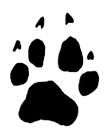The African Wild Dog
Adaptations

PAINTED COAT
The splotchy painted style fur coat is a combination of shades of brown, black, beige, and even yellows and reds. The dogs use their coat markings to help identify and recognize members of the group. The coat acts as camouflage to hide in their natural habitat of grassland, savannahs, and woodland. This coloring is also a benefit while hunting prey because it makes the pack appear larger than it is. Their coats are similar to our fingerprints, where no two are the same. The coloration is thought to also aid in regulating their body temperature.

TEETH
The African wild dog’s has a short and wide muzzle, which allows them to tight grasp and hold on to their prey. Their premolars have evolved to be more blade-like, or carnassial, meaning they're adapted for shearing flesh. This makes them well-suited to taking down prey. An added benefit of having razor-sharp teeth is it decreases consumption time at the kill. Painted wolves are slightly built – the faster they can eat their meal and get out of there, the less likely they will encounter other bigger predators like lion, leopard, and hyena. Their large post-carnassial molars are strong enough to break up large bones.

Muscles
African wild dogs have a vestigial first digit and muscular adaptations for their cursorial lifestyle. Muscles, ligaments, and bones of the forearm are adapted to provide stability to the wrist and elbow, which assists in jumping and with long-distance endurance running to target exhaustion in their prey. Their legs are long and muscular which promote their fast running speeds, reaching highs of 44mph (for reference, the cheetah runs at an average of 50-80 mph and the domestic dog runs at an average of 30 mph).

big round ears
The large rounded mickey mouse-looking ear shape has a few benefits for the dogs. They are able to use them for hearing prey and to communicate with other dogs over large distances (about 2-3 miles). There are several types of calls over a range of frequencies the dogs make, from high-pitched twitters and squeals to low growls and barks.
Additionally, the dogs can even use their large ears to cool off in the extremely hot climate of Africa
(i.e. thermoregulation).

four toes
The African Wild Dog has four toes, unlike other dogs (i.e. domestic) that typically have a fifth toe, the dewclaw. This species evolved to only have four due to their nature of running. These wild dogs are agile hunters that travel over long distances tracking their prey, known as "cursorial animals." They are distinguished for their elongated limbs, shortened digits, and reduced number of toes.
© 2021 by Brandy Turner. Proudly created with Wix.com